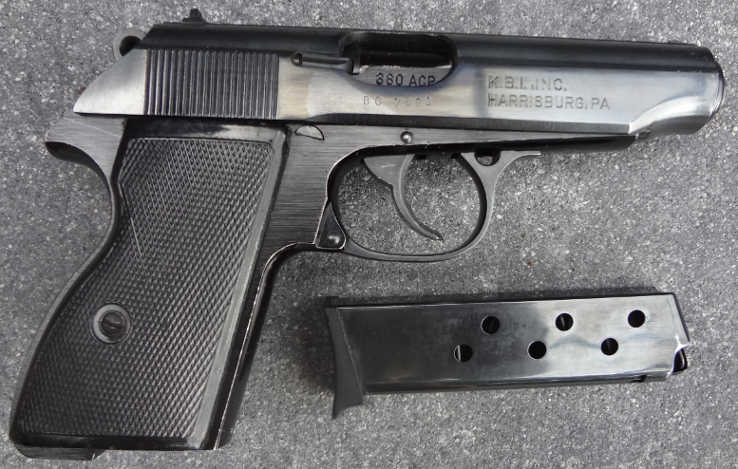Feg Pmk 380 Manual

 A look at the feg pmk.380, enjoy!
A look at the feg pmk.380, enjoy!
I bought this pistol in '93 for a bit under $200 with several extra magazines and a couple of boxes of factory ammunition from a friend who needed money. Initially, I was not too impressed with it as the finish appears to be blue on the slide, trigger, triggerguard, pins, and decocking lever. The frame and exterior of the barrel chamber seem to be painted or black anodized, but if the latter, it's very soft! Toolmarks are not hard to find inside and out; I didn't even shoot the thing for quite a time. Eventually, I did and was pretty favorably surprised! The Pistol: The Hungarian FEG PMK has a 3.9' bbl and is a conventional DA/SA semiautomatic chambered in.380 ACP. I believe some are chambered in 9x18mm Makarov as well.
The single-stack magazine nearly holds 8 rounds, but actually only holds 7. With one in the bbl, the shooter has eight shots on tap in a fully-loaded PMK. The magazine release is behind the triggerguard, but higher than those on such known pistols as the 1911 and P-35. Sights are fixed and tiny with the rear sight drift adjustable for windage. The top of the slide's serrated as is the trigger-face. At the left rear of the slide, is the decocking lever which does remain down unless pushed back upward; when down it prevents the trigger from being pulled and is also an exterior safety.
The magazine is unusual on this pistol. The tab that activates the hold open device is a sprung piece that's part of the magazine follower. It is pressed in when the follower's in the magazine body and springs outward when the follower's all the way up.
You can see it in the picture below. I don't recall having seen this type of thing before! The plastic grips are held on with one screw each and the rear gripstrap is more humped than the Walther PP it so closely imitates. In this picture you can see the small sights, scraped blk anodizing in the ejection port where the aluminum frame surrounds the bbl and the 'Waltheresque' look. The slide has a decent bright blue finish. Knigi karolini grem and acer.
The pistol field-strips in the same manner as the Walter PP-series with the major components being similar. Internally, however, the two pistols differ and parts do NOT interchange. Ammunition: Since pistols of this type are not generally purchased for other than close range personal defense, the bulk of the loads used today are JHPs. One type of ball was used. The rounds used are listed below and the 10-shot average velocity when fired from the PMK is shown in ft/sec.
Fiocchi 95 gr FMJ: 1004 ft/sec PMC 90 gr JHP: 969 ft/sec Winchester 95 gr SXT JHP: 953 ft/sec Federal 90 gr Classic JHP: 1033 ft/sec Federal 90 gr HydraShok JHP: 1036 ft/sec Corbon 90 gr +P JHP: 1110 ft/sec Glaser Silver 70 gr Pre-Fragmented: 1396 ft/sec No handloads were used. Shooting: Today's shooting tests took place at two distances, 7 and 10 yards. Shots were fired standing w/2-hand hold.
No shooting at farther distances were done due to what most will use the pistol for and the small sights. 10 Yards: These are simply 5-shot groups done slow-fire and beginning with the pistol cocked.
Point of aim was 6 O'Clock on the yellow inner dot. Do not assume that the Corbon was truly the most inherently accurate as this pistol was difficult for me to aim with extreme clarity. Still, several of the loads shown produced darned decent groups. I was very surprised to see that the 70 gr Glaser Silver grouped so very well!
This is an improvement over the early versions. It appears that the shot being tightly compressed makes a difference! 7 Yards: This was simply done by raising the pistol from a low-ready to eye level and firing 8 rounds as quickly as possible. The first shot was fired double-action and is the one on the far left of the target.
I used Corbon +P JHP as it had the sharpest recoil and would present the most 'challenge' in recoil-control. 9' closer and the group's significantly larger than above. Speed does that. Maybe a balance of our own personal speed and accuracy levels would be a good thing to keep in mind should we have to fire defensively? Observations: This gun is not ever going to be the top ten for surface finish or high-visibility sights. Finish is utilitarian and whatever the finish is on the frame, it scratches easily. The DA pull is very similar to that of the Walther PP, but the SA, while not bad, is a bit less 'crisp' than on the German/French/American pistol.